Analyzing Tax Implications in Various Australian Case Studies
VerifiedAdded on 2020/04/01
|11
|1766
|68
AI Summary
The assignment entails a detailed analysis of several Australian tax cases involving various aspects such as income derived from forestry activities and timber sales. Key areas include examining the implications under specific sections of the Income Tax Assessment Act (ITAA) 1936 and ITAA 1997, notably focusing on how timber sale advances are treated for taxation purposes. The study also looks at royalty payments as outlined in section 26(f) of the ITAA 1936. Furthermore, it explores broader tax issues such as socially responsible firms' tax obligations, emphasizing understanding both specific case facts and overarching legal principles. References to various scholarly articles provide additional insights into related topics like environmental taxation law and economic efficiency linked with Australian taxes.
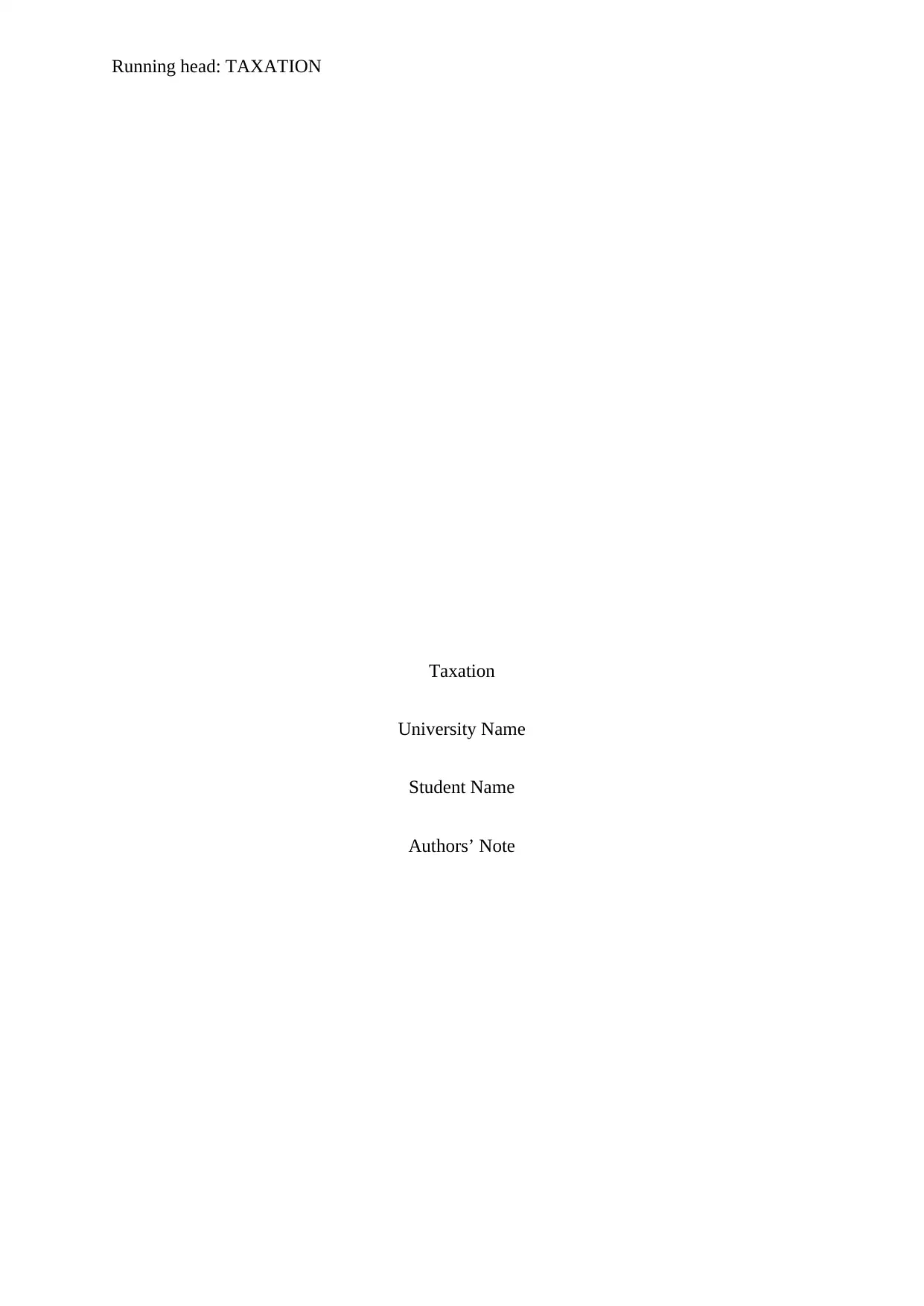
Running head: TAXATION
Taxation
University Name
Student Name
Authors’ Note
Taxation
University Name
Student Name
Authors’ Note
Paraphrase This Document
Need a fresh take? Get an instant paraphrase of this document with our AI Paraphraser
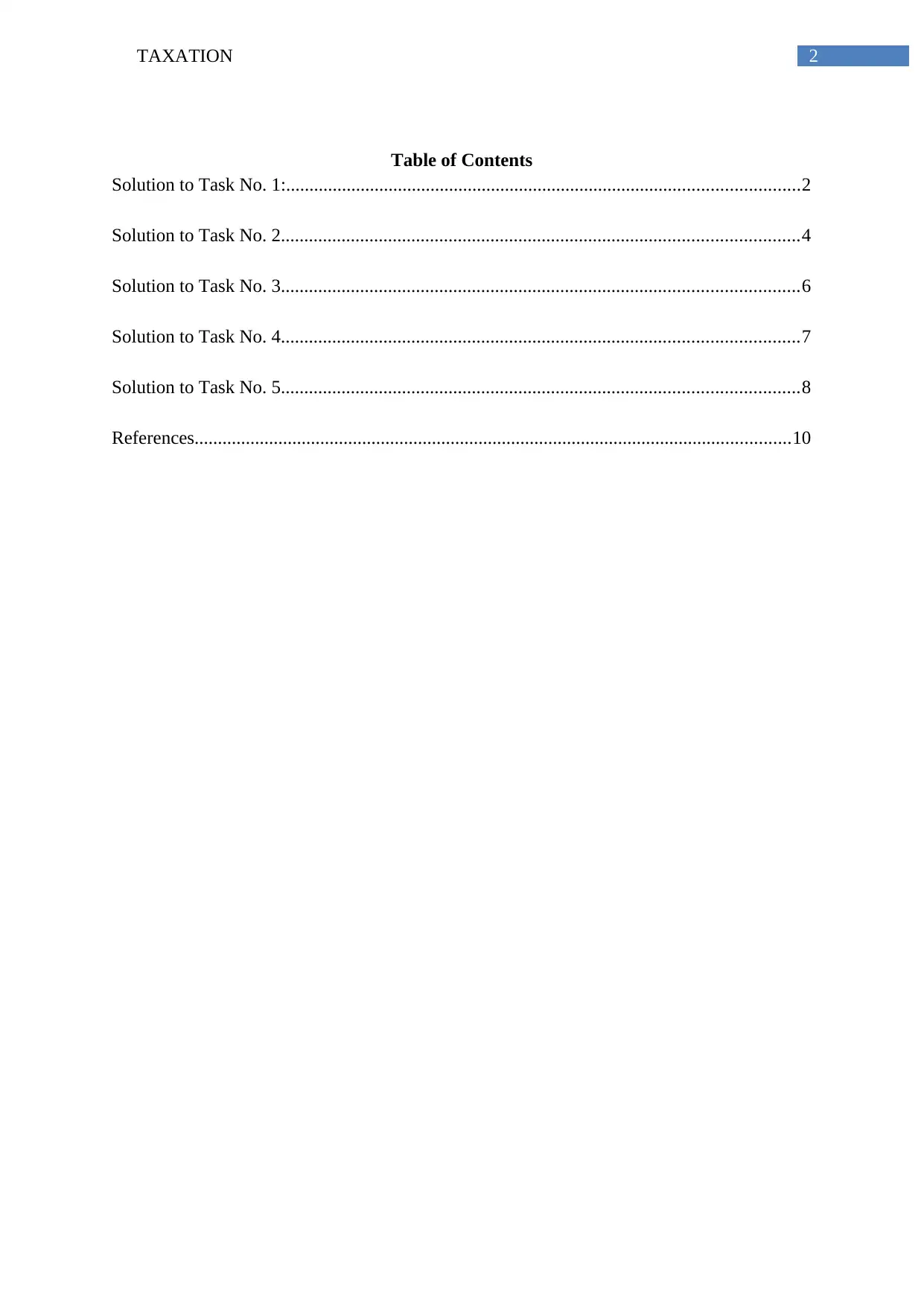
2TAXATION
Table of Contents
Solution to Task No. 1:..............................................................................................................2
Solution to Task No. 2...............................................................................................................4
Solution to Task No. 3...............................................................................................................6
Solution to Task No. 4...............................................................................................................7
Solution to Task No. 5...............................................................................................................8
References................................................................................................................................10
Table of Contents
Solution to Task No. 1:..............................................................................................................2
Solution to Task No. 2...............................................................................................................4
Solution to Task No. 3...............................................................................................................6
Solution to Task No. 4...............................................................................................................7
Solution to Task No. 5...............................................................................................................8
References................................................................................................................................10
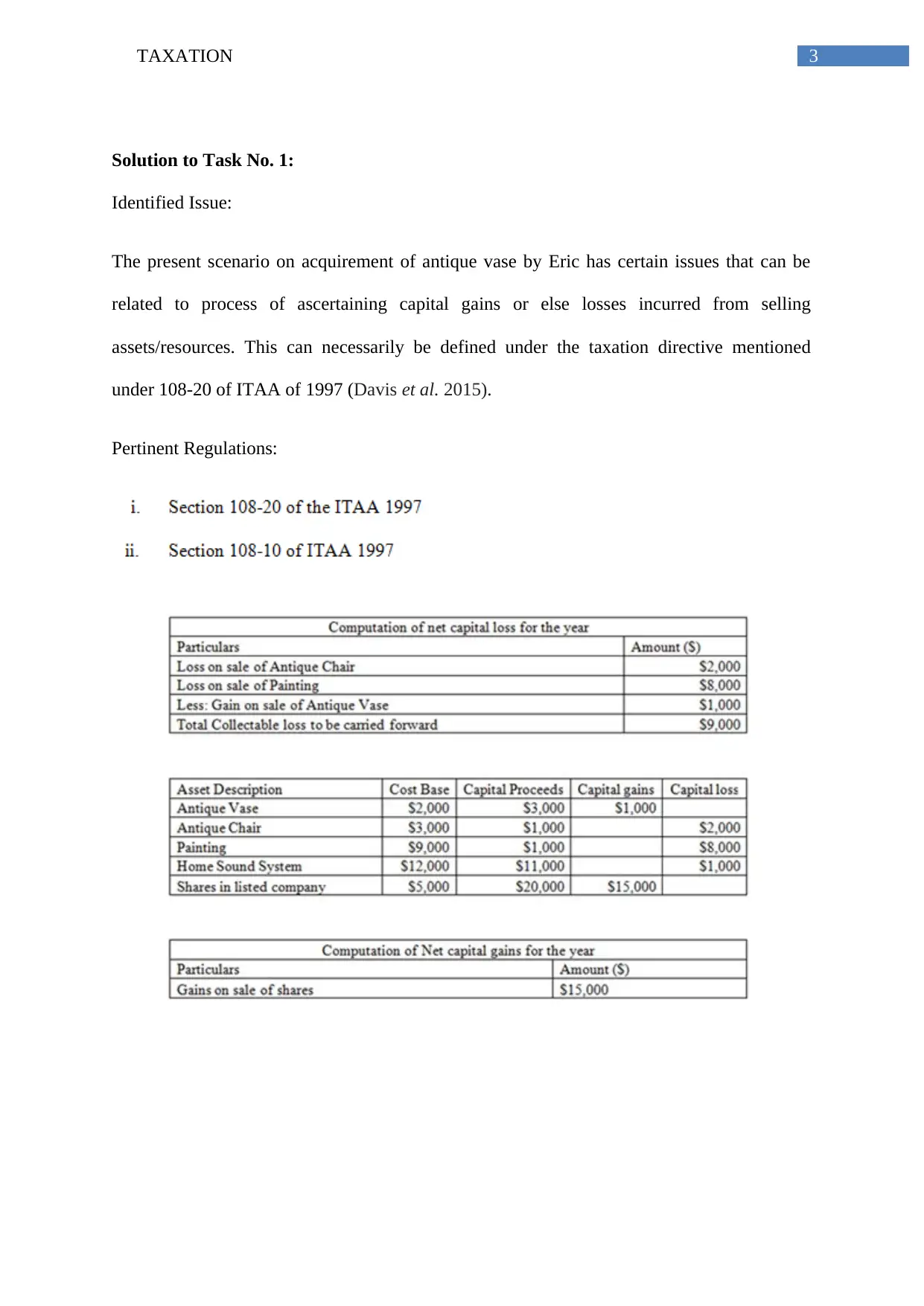
3TAXATION
Solution to Task No. 1:
Identified Issue:
The present scenario on acquirement of antique vase by Eric has certain issues that can be
related to process of ascertaining capital gains or else losses incurred from selling
assets/resources. This can necessarily be defined under the taxation directive mentioned
under 108-20 of ITAA of 1997 (Davis et al. 2015).
Pertinent Regulations:
Solution to Task No. 1:
Identified Issue:
The present scenario on acquirement of antique vase by Eric has certain issues that can be
related to process of ascertaining capital gains or else losses incurred from selling
assets/resources. This can necessarily be defined under the taxation directive mentioned
under 108-20 of ITAA of 1997 (Davis et al. 2015).
Pertinent Regulations:
⊘ This is a preview!⊘
Do you want full access?
Subscribe today to unlock all pages.

Trusted by 1+ million students worldwide
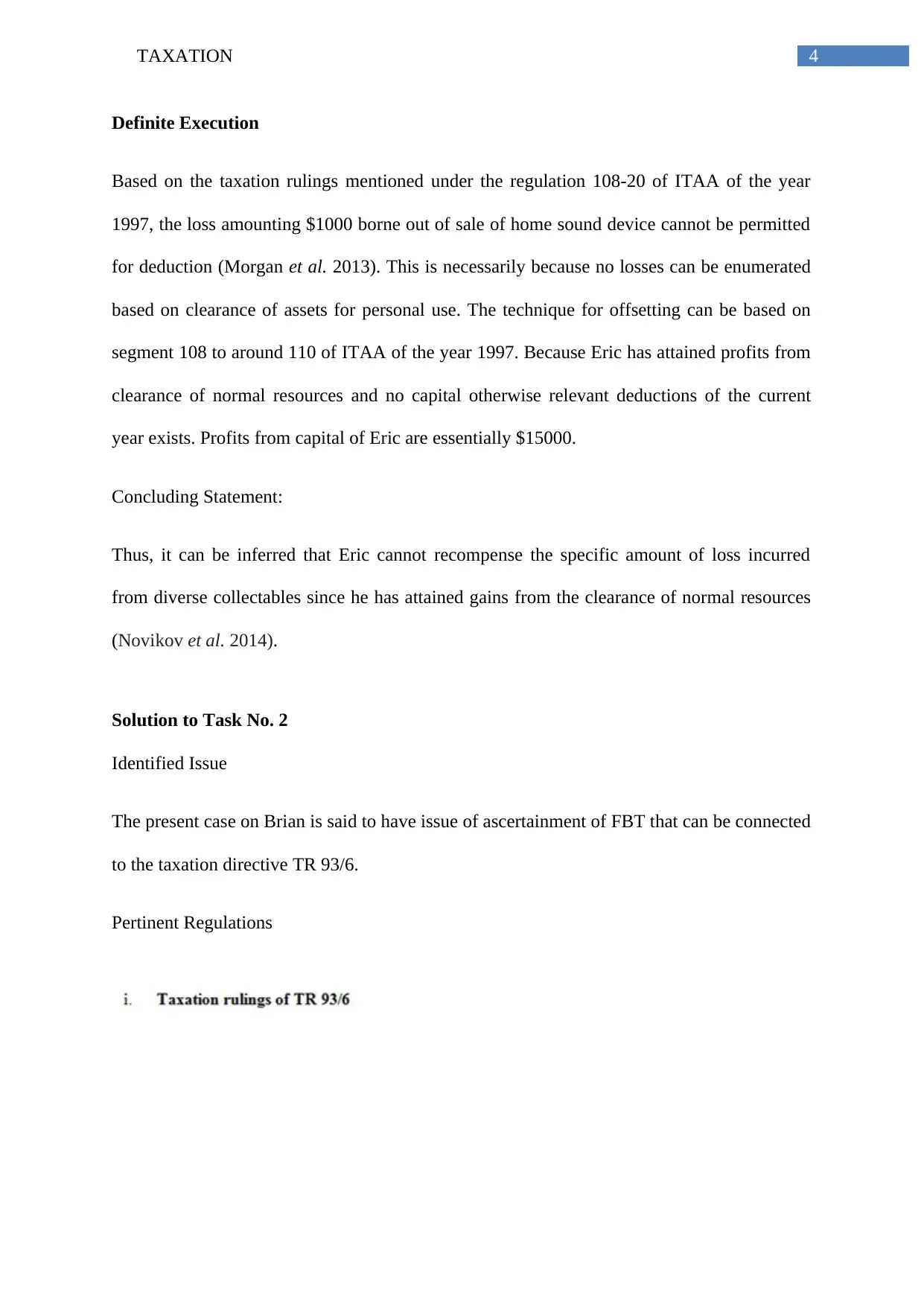
4TAXATION
Definite Execution
Based on the taxation rulings mentioned under the regulation 108-20 of ITAA of the year
1997, the loss amounting $1000 borne out of sale of home sound device cannot be permitted
for deduction (Morgan et al. 2013). This is necessarily because no losses can be enumerated
based on clearance of assets for personal use. The technique for offsetting can be based on
segment 108 to around 110 of ITAA of the year 1997. Because Eric has attained profits from
clearance of normal resources and no capital otherwise relevant deductions of the current
year exists. Profits from capital of Eric are essentially $15000.
Concluding Statement:
Thus, it can be inferred that Eric cannot recompense the specific amount of loss incurred
from diverse collectables since he has attained gains from the clearance of normal resources
(Novikov et al. 2014).
Solution to Task No. 2
Identified Issue
The present case on Brian is said to have issue of ascertainment of FBT that can be connected
to the taxation directive TR 93/6.
Pertinent Regulations
Definite Execution
Based on the taxation rulings mentioned under the regulation 108-20 of ITAA of the year
1997, the loss amounting $1000 borne out of sale of home sound device cannot be permitted
for deduction (Morgan et al. 2013). This is necessarily because no losses can be enumerated
based on clearance of assets for personal use. The technique for offsetting can be based on
segment 108 to around 110 of ITAA of the year 1997. Because Eric has attained profits from
clearance of normal resources and no capital otherwise relevant deductions of the current
year exists. Profits from capital of Eric are essentially $15000.
Concluding Statement:
Thus, it can be inferred that Eric cannot recompense the specific amount of loss incurred
from diverse collectables since he has attained gains from the clearance of normal resources
(Novikov et al. 2014).
Solution to Task No. 2
Identified Issue
The present case on Brian is said to have issue of ascertainment of FBT that can be connected
to the taxation directive TR 93/6.
Pertinent Regulations
Paraphrase This Document
Need a fresh take? Get an instant paraphrase of this document with our AI Paraphraser
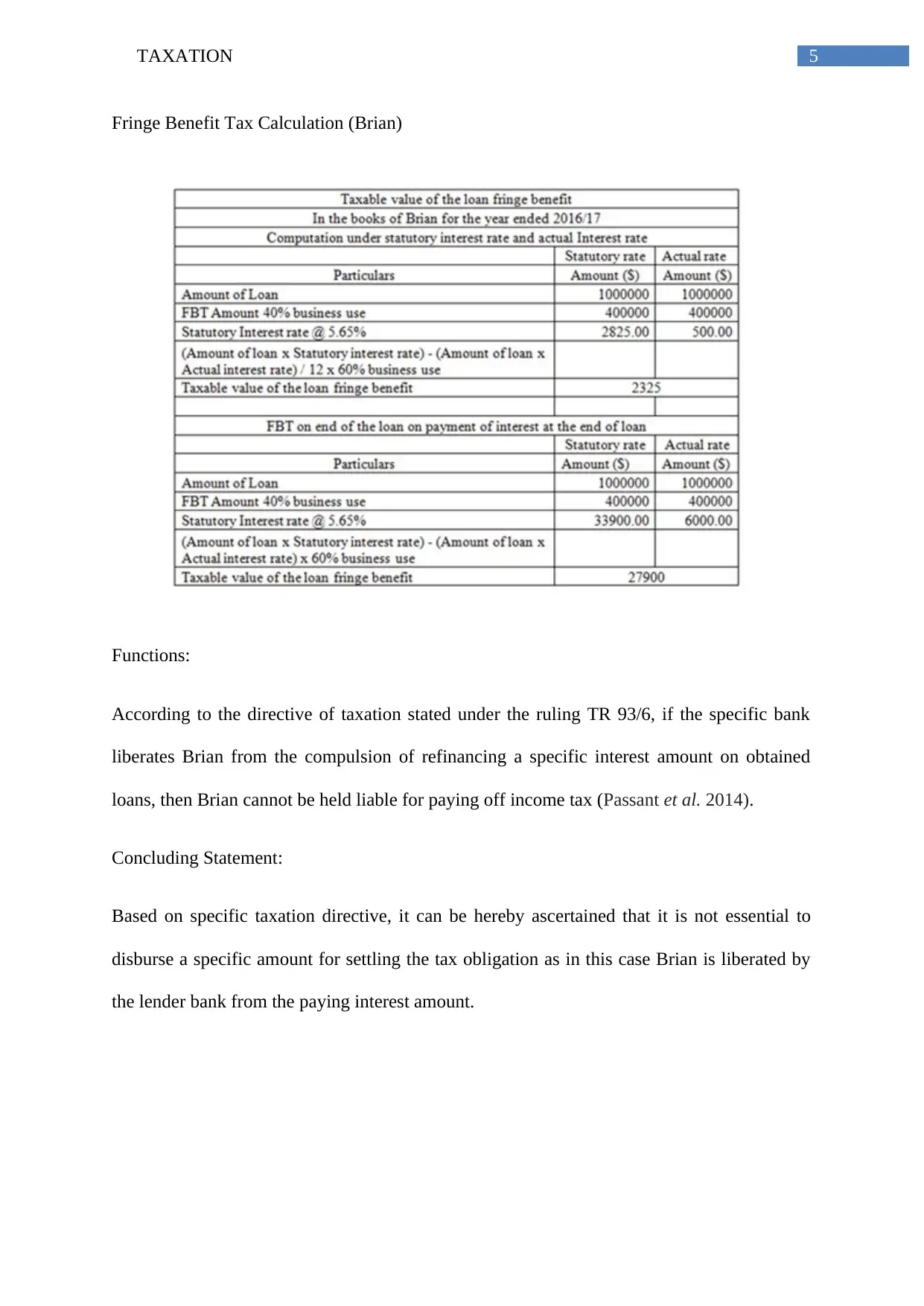
5TAXATION
Fringe Benefit Tax Calculation (Brian)
Functions:
According to the directive of taxation stated under the ruling TR 93/6, if the specific bank
liberates Brian from the compulsion of refinancing a specific interest amount on obtained
loans, then Brian cannot be held liable for paying off income tax (Passant et al. 2014).
Concluding Statement:
Based on specific taxation directive, it can be hereby ascertained that it is not essential to
disburse a specific amount for settling the tax obligation as in this case Brian is liberated by
the lender bank from the paying interest amount.
Fringe Benefit Tax Calculation (Brian)
Functions:
According to the directive of taxation stated under the ruling TR 93/6, if the specific bank
liberates Brian from the compulsion of refinancing a specific interest amount on obtained
loans, then Brian cannot be held liable for paying off income tax (Passant et al. 2014).
Concluding Statement:
Based on specific taxation directive, it can be hereby ascertained that it is not essential to
disburse a specific amount for settling the tax obligation as in this case Brian is liberated by
the lender bank from the paying interest amount.
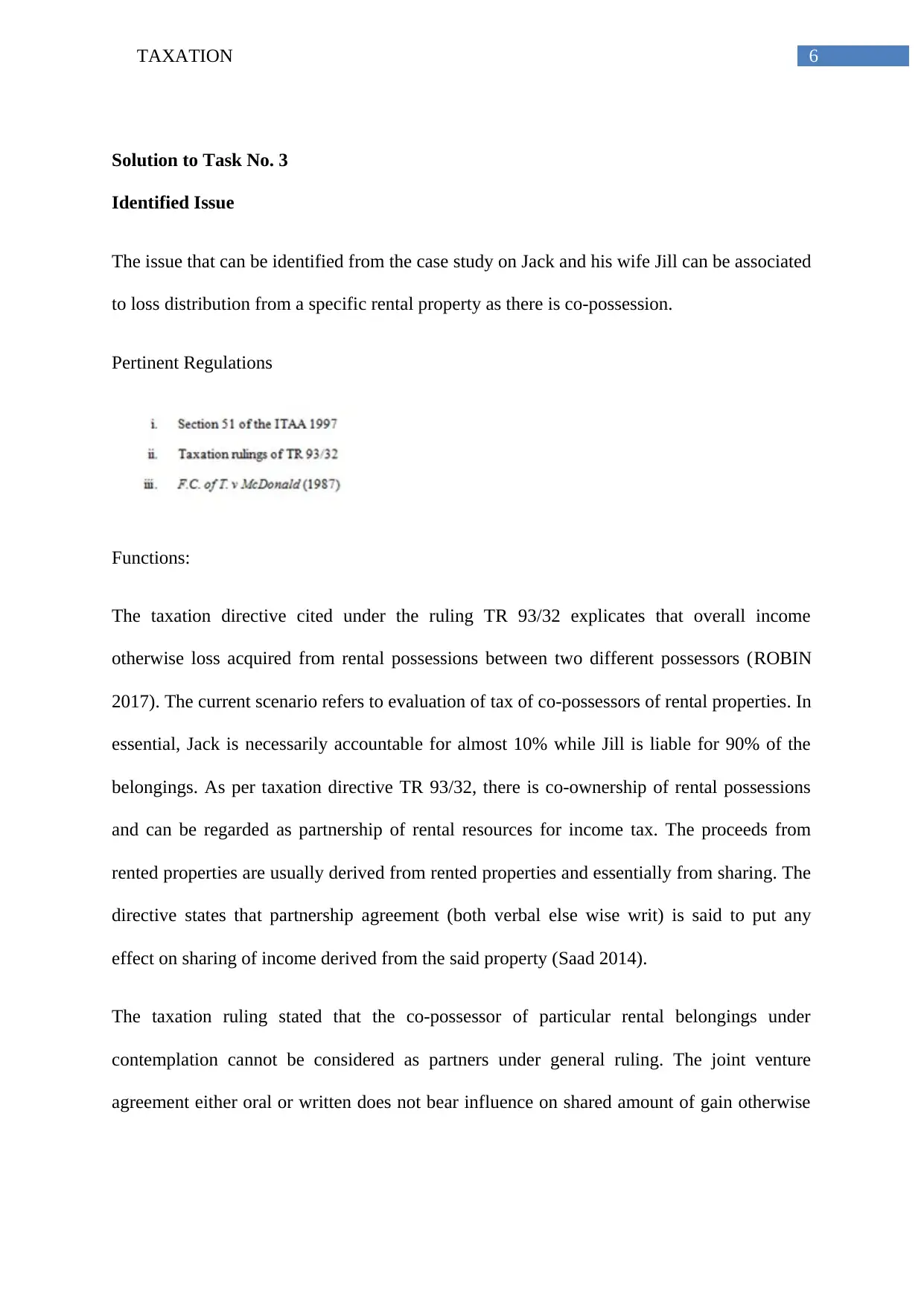
6TAXATION
Solution to Task No. 3
Identified Issue
The issue that can be identified from the case study on Jack and his wife Jill can be associated
to loss distribution from a specific rental property as there is co-possession.
Pertinent Regulations
Functions:
The taxation directive cited under the ruling TR 93/32 explicates that overall income
otherwise loss acquired from rental possessions between two different possessors (ROBIN
2017). The current scenario refers to evaluation of tax of co-possessors of rental properties. In
essential, Jack is necessarily accountable for almost 10% while Jill is liable for 90% of the
belongings. As per taxation directive TR 93/32, there is co-ownership of rental possessions
and can be regarded as partnership of rental resources for income tax. The proceeds from
rented properties are usually derived from rented properties and essentially from sharing. The
directive states that partnership agreement (both verbal else wise writ) is said to put any
effect on sharing of income derived from the said property (Saad 2014).
The taxation ruling stated that the co-possessor of particular rental belongings under
contemplation cannot be considered as partners under general ruling. The joint venture
agreement either oral or written does not bear influence on shared amount of gain otherwise
Solution to Task No. 3
Identified Issue
The issue that can be identified from the case study on Jack and his wife Jill can be associated
to loss distribution from a specific rental property as there is co-possession.
Pertinent Regulations
Functions:
The taxation directive cited under the ruling TR 93/32 explicates that overall income
otherwise loss acquired from rental possessions between two different possessors (ROBIN
2017). The current scenario refers to evaluation of tax of co-possessors of rental properties. In
essential, Jack is necessarily accountable for almost 10% while Jill is liable for 90% of the
belongings. As per taxation directive TR 93/32, there is co-ownership of rental possessions
and can be regarded as partnership of rental resources for income tax. The proceeds from
rented properties are usually derived from rented properties and essentially from sharing. The
directive states that partnership agreement (both verbal else wise writ) is said to put any
effect on sharing of income derived from the said property (Saad 2014).
The taxation ruling stated that the co-possessor of particular rental belongings under
contemplation cannot be considered as partners under general ruling. The joint venture
agreement either oral or written does not bear influence on shared amount of gain otherwise
⊘ This is a preview!⊘
Do you want full access?
Subscribe today to unlock all pages.

Trusted by 1+ million students worldwide
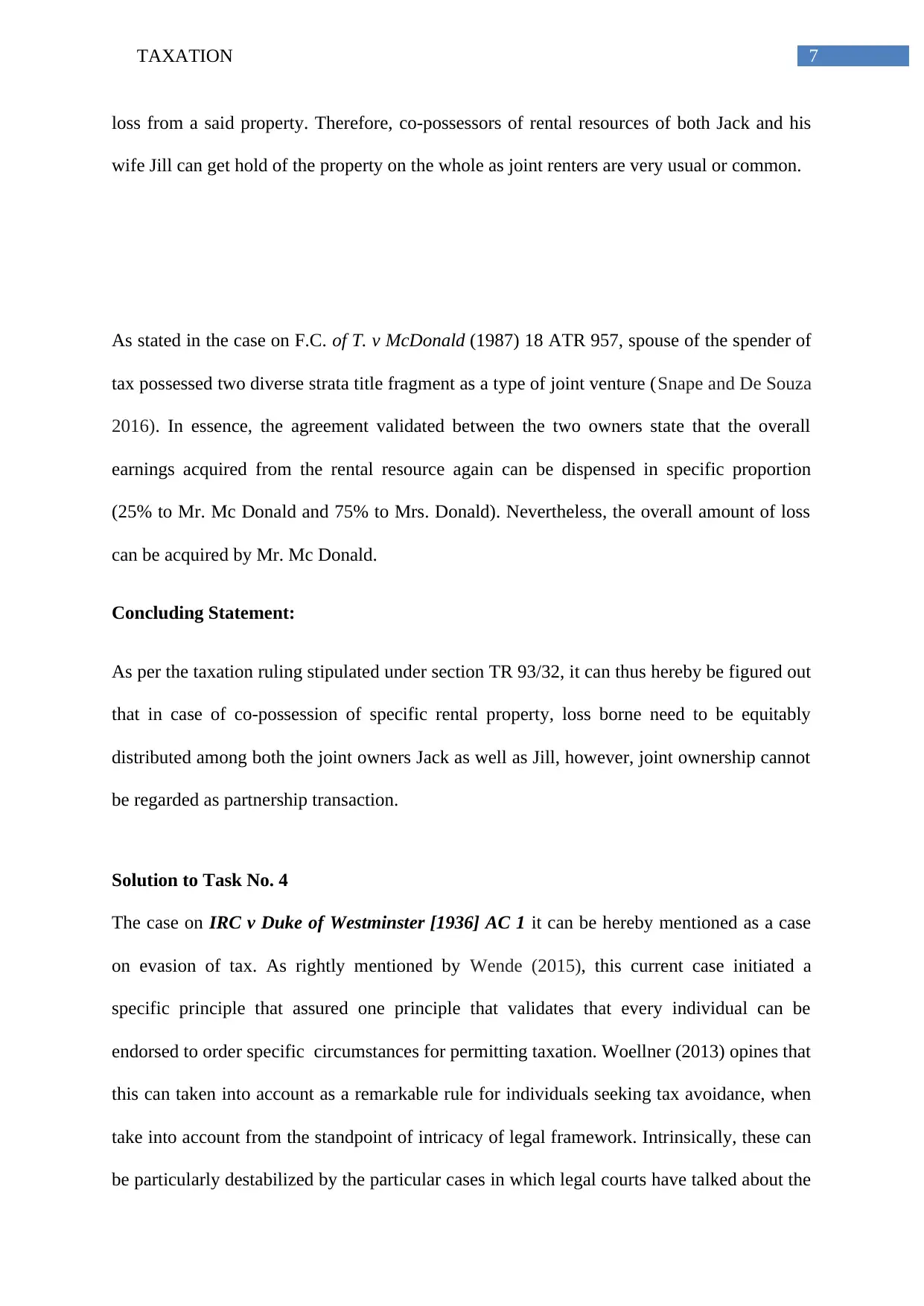
7TAXATION
loss from a said property. Therefore, co-possessors of rental resources of both Jack and his
wife Jill can get hold of the property on the whole as joint renters are very usual or common.
As stated in the case on F.C. of T. v McDonald (1987) 18 ATR 957, spouse of the spender of
tax possessed two diverse strata title fragment as a type of joint venture (Snape and De Souza
2016). In essence, the agreement validated between the two owners state that the overall
earnings acquired from the rental resource again can be dispensed in specific proportion
(25% to Mr. Mc Donald and 75% to Mrs. Donald). Nevertheless, the overall amount of loss
can be acquired by Mr. Mc Donald.
Concluding Statement:
As per the taxation ruling stipulated under section TR 93/32, it can thus hereby be figured out
that in case of co-possession of specific rental property, loss borne need to be equitably
distributed among both the joint owners Jack as well as Jill, however, joint ownership cannot
be regarded as partnership transaction.
Solution to Task No. 4
The case on IRC v Duke of Westminster [1936] AC 1 it can be hereby mentioned as a case
on evasion of tax. As rightly mentioned by Wende (2015), this current case initiated a
specific principle that assured one principle that validates that every individual can be
endorsed to order specific circumstances for permitting taxation. Woellner (2013) opines that
this can taken into account as a remarkable rule for individuals seeking tax avoidance, when
take into account from the standpoint of intricacy of legal framework. Intrinsically, these can
be particularly destabilized by the particular cases in which legal courts have talked about the
loss from a said property. Therefore, co-possessors of rental resources of both Jack and his
wife Jill can get hold of the property on the whole as joint renters are very usual or common.
As stated in the case on F.C. of T. v McDonald (1987) 18 ATR 957, spouse of the spender of
tax possessed two diverse strata title fragment as a type of joint venture (Snape and De Souza
2016). In essence, the agreement validated between the two owners state that the overall
earnings acquired from the rental resource again can be dispensed in specific proportion
(25% to Mr. Mc Donald and 75% to Mrs. Donald). Nevertheless, the overall amount of loss
can be acquired by Mr. Mc Donald.
Concluding Statement:
As per the taxation ruling stipulated under section TR 93/32, it can thus hereby be figured out
that in case of co-possession of specific rental property, loss borne need to be equitably
distributed among both the joint owners Jack as well as Jill, however, joint ownership cannot
be regarded as partnership transaction.
Solution to Task No. 4
The case on IRC v Duke of Westminster [1936] AC 1 it can be hereby mentioned as a case
on evasion of tax. As rightly mentioned by Wende (2015), this current case initiated a
specific principle that assured one principle that validates that every individual can be
endorsed to order specific circumstances for permitting taxation. Woellner (2013) opines that
this can taken into account as a remarkable rule for individuals seeking tax avoidance, when
take into account from the standpoint of intricacy of legal framework. Intrinsically, these can
be particularly destabilized by the particular cases in which legal courts have talked about the
Paraphrase This Document
Need a fresh take? Get an instant paraphrase of this document with our AI Paraphraser
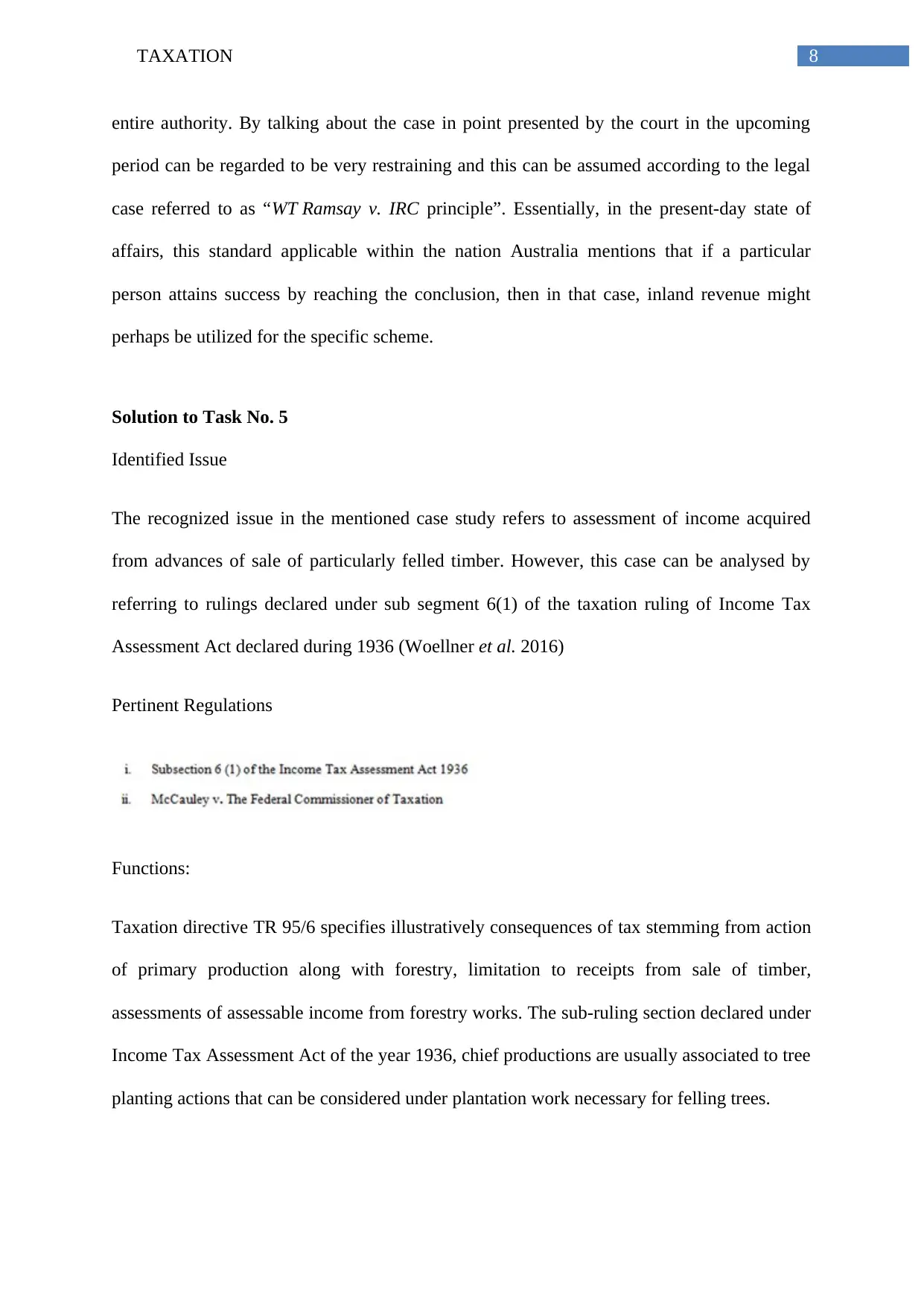
8TAXATION
entire authority. By talking about the case in point presented by the court in the upcoming
period can be regarded to be very restraining and this can be assumed according to the legal
case referred to as “WT Ramsay v. IRC principle”. Essentially, in the present-day state of
affairs, this standard applicable within the nation Australia mentions that if a particular
person attains success by reaching the conclusion, then in that case, inland revenue might
perhaps be utilized for the specific scheme.
Solution to Task No. 5
Identified Issue
The recognized issue in the mentioned case study refers to assessment of income acquired
from advances of sale of particularly felled timber. However, this case can be analysed by
referring to rulings declared under sub segment 6(1) of the taxation ruling of Income Tax
Assessment Act declared during 1936 (Woellner et al. 2016)
Pertinent Regulations
Functions:
Taxation directive TR 95/6 specifies illustratively consequences of tax stemming from action
of primary production along with forestry, limitation to receipts from sale of timber,
assessments of assessable income from forestry works. The sub-ruling section declared under
Income Tax Assessment Act of the year 1936, chief productions are usually associated to tree
planting actions that can be considered under plantation work necessary for felling trees.
entire authority. By talking about the case in point presented by the court in the upcoming
period can be regarded to be very restraining and this can be assumed according to the legal
case referred to as “WT Ramsay v. IRC principle”. Essentially, in the present-day state of
affairs, this standard applicable within the nation Australia mentions that if a particular
person attains success by reaching the conclusion, then in that case, inland revenue might
perhaps be utilized for the specific scheme.
Solution to Task No. 5
Identified Issue
The recognized issue in the mentioned case study refers to assessment of income acquired
from advances of sale of particularly felled timber. However, this case can be analysed by
referring to rulings declared under sub segment 6(1) of the taxation ruling of Income Tax
Assessment Act declared during 1936 (Woellner et al. 2016)
Pertinent Regulations
Functions:
Taxation directive TR 95/6 specifies illustratively consequences of tax stemming from action
of primary production along with forestry, limitation to receipts from sale of timber,
assessments of assessable income from forestry works. The sub-ruling section declared under
Income Tax Assessment Act of the year 1936, chief productions are usually associated to tree
planting actions that can be considered under plantation work necessary for felling trees.
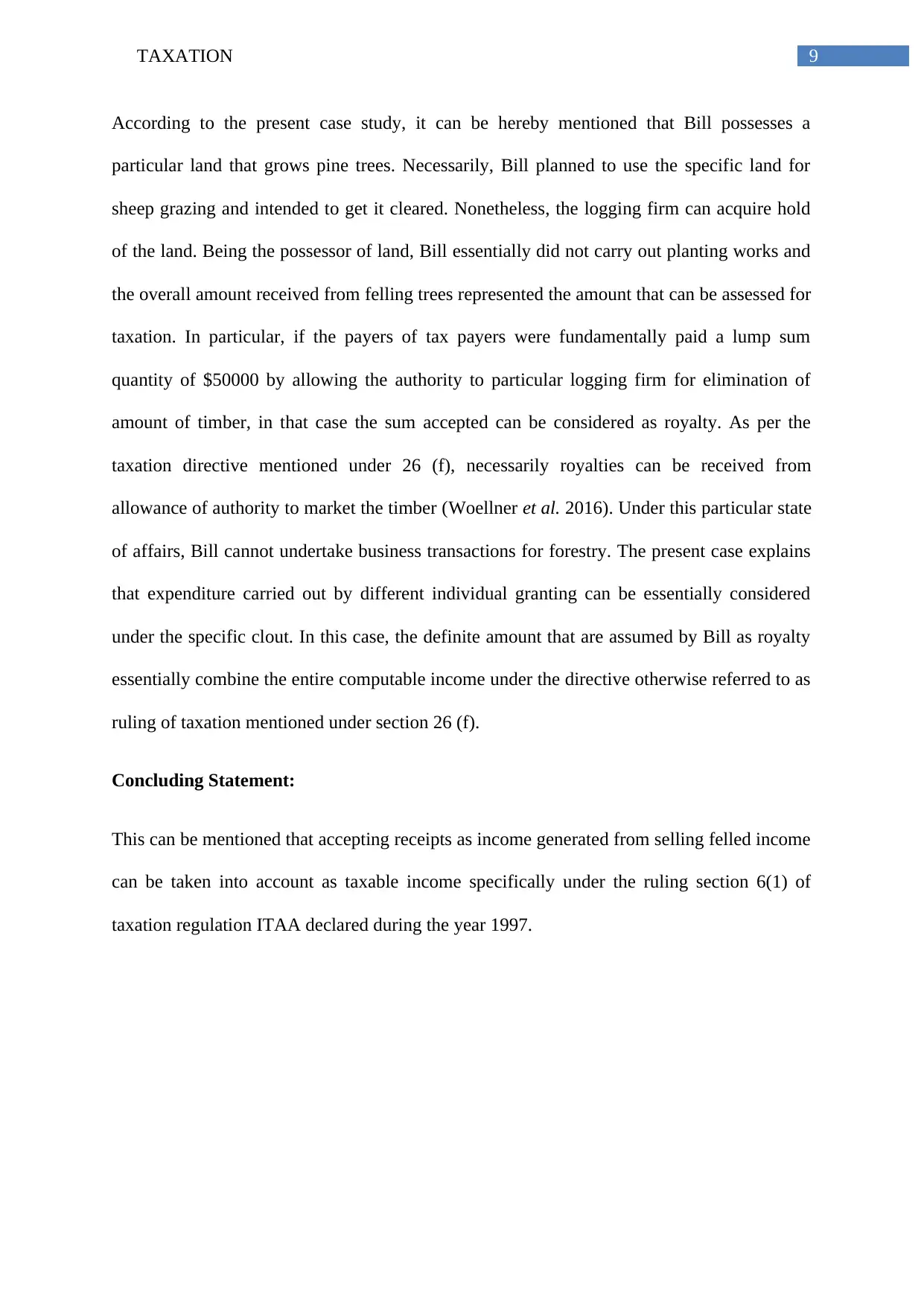
9TAXATION
According to the present case study, it can be hereby mentioned that Bill possesses a
particular land that grows pine trees. Necessarily, Bill planned to use the specific land for
sheep grazing and intended to get it cleared. Nonetheless, the logging firm can acquire hold
of the land. Being the possessor of land, Bill essentially did not carry out planting works and
the overall amount received from felling trees represented the amount that can be assessed for
taxation. In particular, if the payers of tax payers were fundamentally paid a lump sum
quantity of $50000 by allowing the authority to particular logging firm for elimination of
amount of timber, in that case the sum accepted can be considered as royalty. As per the
taxation directive mentioned under 26 (f), necessarily royalties can be received from
allowance of authority to market the timber (Woellner et al. 2016). Under this particular state
of affairs, Bill cannot undertake business transactions for forestry. The present case explains
that expenditure carried out by different individual granting can be essentially considered
under the specific clout. In this case, the definite amount that are assumed by Bill as royalty
essentially combine the entire computable income under the directive otherwise referred to as
ruling of taxation mentioned under section 26 (f).
Concluding Statement:
This can be mentioned that accepting receipts as income generated from selling felled income
can be taken into account as taxable income specifically under the ruling section 6(1) of
taxation regulation ITAA declared during the year 1997.
According to the present case study, it can be hereby mentioned that Bill possesses a
particular land that grows pine trees. Necessarily, Bill planned to use the specific land for
sheep grazing and intended to get it cleared. Nonetheless, the logging firm can acquire hold
of the land. Being the possessor of land, Bill essentially did not carry out planting works and
the overall amount received from felling trees represented the amount that can be assessed for
taxation. In particular, if the payers of tax payers were fundamentally paid a lump sum
quantity of $50000 by allowing the authority to particular logging firm for elimination of
amount of timber, in that case the sum accepted can be considered as royalty. As per the
taxation directive mentioned under 26 (f), necessarily royalties can be received from
allowance of authority to market the timber (Woellner et al. 2016). Under this particular state
of affairs, Bill cannot undertake business transactions for forestry. The present case explains
that expenditure carried out by different individual granting can be essentially considered
under the specific clout. In this case, the definite amount that are assumed by Bill as royalty
essentially combine the entire computable income under the directive otherwise referred to as
ruling of taxation mentioned under section 26 (f).
Concluding Statement:
This can be mentioned that accepting receipts as income generated from selling felled income
can be taken into account as taxable income specifically under the ruling section 6(1) of
taxation regulation ITAA declared during the year 1997.
⊘ This is a preview!⊘
Do you want full access?
Subscribe today to unlock all pages.

Trusted by 1+ million students worldwide

10TAXATION
References
Davis, A.K., Guenther, D.A., Krull, L.K. and Williams, B.M., 2015. Do socially responsible
firms pay more taxes?. The Accounting Review, 91(1), pp.47-68.
Morgan, A., Mortimer, C. and Pinto, D. 2013. A practical introduction to Australian taxation
law. North Ryde [N.S.W.]: CCH Australia.
Novikov, A.A., Ling, T.G. and Kordzakhia, N., 2014. Pricing of volume-weighted average
options: Analytical approximations and numerical results. In Inspired by Finance (pp. 461-
474). Springer International Publishing.
Passant, J., McLaren, J.A. and Silaen, P., 2014. Are returns received by householders from
electricity generated by solar panels assessable income?.
ROBIN, H., 2017. AUSTRALIAN TAXATION LAW 2017. OXFORD University Press.
Saad, N., 2014. Tax knowledge, tax complexity and tax compliance: Taxpayers’
view. Procedia-Social and Behavioral Sciences, 109, pp.1069-1075.
Snape, J. and De Souza, J., 2016. Environmental taxation law: policy, contexts and practice.
Routledge.
Wende, S., 2015. Understanding the economy-widze efficiency and incidence of major
Australian taxes. Treasury WP, 1.
Woellner, R. 2013. Australian taxation law select 2013. North Ryde, N.S.W.: CCH Australia.
Woellner, R., Barkoczy, S., Murphy, S., Evans, C. and Pinto, D., 2016. Australian Taxation
Law 2016. OUP Catalogue.
References
Davis, A.K., Guenther, D.A., Krull, L.K. and Williams, B.M., 2015. Do socially responsible
firms pay more taxes?. The Accounting Review, 91(1), pp.47-68.
Morgan, A., Mortimer, C. and Pinto, D. 2013. A practical introduction to Australian taxation
law. North Ryde [N.S.W.]: CCH Australia.
Novikov, A.A., Ling, T.G. and Kordzakhia, N., 2014. Pricing of volume-weighted average
options: Analytical approximations and numerical results. In Inspired by Finance (pp. 461-
474). Springer International Publishing.
Passant, J., McLaren, J.A. and Silaen, P., 2014. Are returns received by householders from
electricity generated by solar panels assessable income?.
ROBIN, H., 2017. AUSTRALIAN TAXATION LAW 2017. OXFORD University Press.
Saad, N., 2014. Tax knowledge, tax complexity and tax compliance: Taxpayers’
view. Procedia-Social and Behavioral Sciences, 109, pp.1069-1075.
Snape, J. and De Souza, J., 2016. Environmental taxation law: policy, contexts and practice.
Routledge.
Wende, S., 2015. Understanding the economy-widze efficiency and incidence of major
Australian taxes. Treasury WP, 1.
Woellner, R. 2013. Australian taxation law select 2013. North Ryde, N.S.W.: CCH Australia.
Woellner, R., Barkoczy, S., Murphy, S., Evans, C. and Pinto, D., 2016. Australian Taxation
Law 2016. OUP Catalogue.
Paraphrase This Document
Need a fresh take? Get an instant paraphrase of this document with our AI Paraphraser

11TAXATION
1 out of 11
Related Documents
Your All-in-One AI-Powered Toolkit for Academic Success.
+13062052269
info@desklib.com
Available 24*7 on WhatsApp / Email
![[object Object]](/_next/static/media/star-bottom.7253800d.svg)
Unlock your academic potential
Copyright © 2020–2025 A2Z Services. All Rights Reserved. Developed and managed by ZUCOL.
![Taxation Law Analysis Assignment - [University Name]](/_next/image/?url=https%3A%2F%2Fdesklib.com%2Fmedia%2Fimages%2F237a5b831ee046ecb975c30288c0819d.jpg&w=256&q=75)




